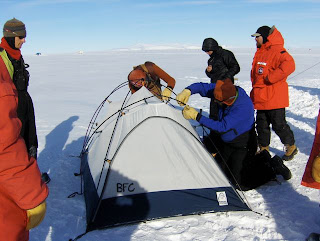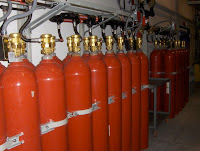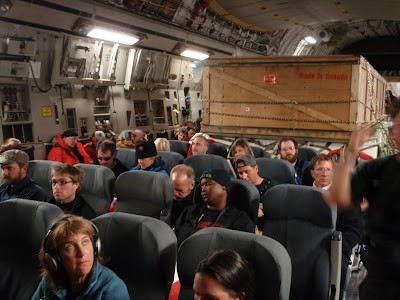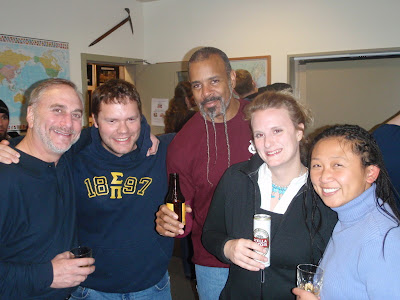In the last entry, I mentioned the upcoming Snow Craft Training, affectionately known as "Happy Camper". I went and had a great time. Unfortunately, my fingers didn't enjoy it as much as the rest of me. More about that in a minute.

Happy Camper started with classroom education on camping in the snow environment. We discussed shelter, proper clothing, sun exposure, frostbite and other survival topics. There were 20 students in the group and two instructors. All the students showed up with their ECW and extra gloves, mittens, hats, and other protective gear.
After the classroom training we filed out to the transport vehicles

(a Delta and a van) and loaded them with our personal gear and some camping equipment (stoves, and food, mostly). After a brief stop at the galley to pick up our lunch, we were off to the field. Our ride took us out onto the Ross Ice Shelf. We unloaded from the
Delta and transferred the gear to a sled towed by a snow mobile.

We then walked 20 minutes to a small hut where we received a briefing on how to set up, care for, and repair the camp stoves. The ones we used ran on a small cylinder of white gas (Coleman fuel) that is pressurized with a small integrated hand pump.

After some more classroom training, orientation and lunch we loaded up the sled with sleeping bags and marched out into the open ice field. Once there we were taught how to set up a
Scott tent,

build a
quinzee, pitch a mountain tent, build a wind wall of snow blocks, and use trenches as sleeping shelter.

I made a
short video that shows the building of our quinzee but am prevented from uploading it because of limited bandwidth.

We mounded up all the bags, covered them with a tarp, mounded snow, let it set up for a couple of hours, tunnelled into it, dragged out the bags, and
voilá, it is done.

We used the snow blocks to build a wind barrier wall.

Later, our instructors departed. We had to figure out a method for firing up the camp stoves, melting snow, and then boiling water. The boiled water was used for instant coffee, tea, instant hot chocolate, or instant hot spiced apple cider. The hot water could also be used to rehydrate dehydrated meals. There were also candy bars, mixed nuts (just like us), and "gorp" - a trail mix-like conglomeration of nuts and chocolate chips. I ate just from this latter group of foods plus some hot chocolate. Almost all foodstuffs were years past their expiration date (e.g. "Best if used by: 07-05").

The view of Mount Erebus and its almost constant volcanic plume was spectacular. The wind carries the plume in a sideways drift, making the plume look like a cloud. In this shot you can also see a helicopter on a training mission.
I chose to sleep in a mountain tent.

I've slept well in these in the past and hoped for the same experience this time. Alas, that was not my fate this trip. I slept fitfully, waking often. Footfalls of other campers were very loud in the snow and the almost constant sunlight was a distraction. I wore thermal wool socks on my feet and glove liners with hand warmers inside on my hands to keep everything warm at night. My feet felt great and never bothered me, but my hands often felt cold and would wake me. When I got up in the morning and got dressed, I noticed that my fingers were hurting when I tried to tie my bootlaces and didn't fit easily into my gloves. After reassembling in the hut, I removed my gloves and, to my horror, found frostbitten fingers. See the photo of my left hand.

The third, fourth and fifth digits of both hands are frostbitten. You can see the color change at the last part of the fingers The pinkies are the worst on each hand. This is a classic example of first and second degree frostbite. It is also an example of how, despite taking all the precautions, it can still occur. Fortunately, after some blistering and peeling, they will heal fine. Right now, they have no sense of touch (I wouldn't feel a pin-prick) but are very painful deep inside and very tender if pressure is applied. Because of this, the entire blog entry was made with my two first fingers and thumbs in a hunt 'n peck style of keyboarding.
The rest of the morning consisted of VHF and HF radio training, simulating a search and rescue under white-out conditions, risk management discussions, and leadership education. Our return to base was uneventful and used the same vehicles.



































